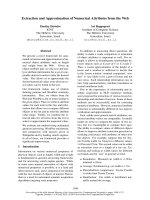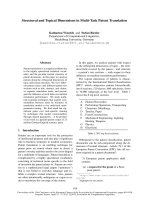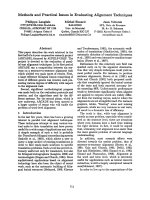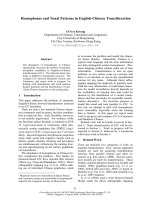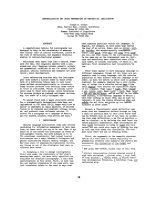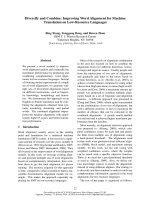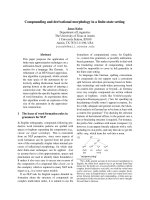Báo cáo khoa học: "Iron and iron/manganese ratio in forage from Icelandic sheep farms: relation to scrapie" docx
Bạn đang xem bản rút gọn của tài liệu. Xem và tải ngay bản đầy đủ của tài liệu tại đây (234.08 KB, 5 trang )
BioMed Central
Page 1 of 5
(page number not for citation purposes)
Acta Veterinaria Scandinavica
Open Access
Research
Iron and iron/manganese ratio in forage from Icelandic sheep farms:
relation to scrapie
KB Gudmundsdóttir*
1
, S Sigurdarson
1
, J Kristinsson
2
, T Eiríksson
3
and
T Jóhannesson
2
Address:
1
Chief Veterinary Office, Section for Animal Diseases. Institute for Experimental Pathology, University of Iceland, Keldur, 112 Reykjavík,
Iceland,
2
Institute of Pharmacy, Pharmacology & Toxicology, Department of Pharmacology and Toxicology, University of Iceland, Hofsvallagata
53, 107 Reykjavík, Iceland and
3
Department of Animal and Land Resources, Agricultural University of Iceland, Keldnaholt, 112 Reykjavík, Iceland
Email: KB Gudmundsdóttir* - ; S Sigurdarson - ; J Kristinsson - ; T Eiríksson - ;
T Jóhannesson -
* Corresponding author
Abstract
This study was undertaken in order to examine whether any connection existed between the
amounts of iron in forage and the sporadic occurrence of scrapie observed in certain parts of
Iceland. As iron and manganese are considered antagonistic in plants, calculation of the Fe/Mn ratios
was also included by using results from Mn determination earlier performed in the same samples.
Forage samples (n = 170) from the summer harvests of 2001–2003, were collected from 47 farms
for iron and manganese analysis. The farms were divided into four categories: 1. Scrapie-free farms
in scrapie-free areas (n = 9); 2. Scrapie-free farms in scrapie-afflicted areas (n = 17); 3. Scrapie-prone
farms (earlier scrapie-afflicted, restocked farms) (n = 12); 4. Scrapie-afflicted farms (n = 9). Farms in
categories 1 and 2 are collectively referred to as scrapie-free farms. The mean iron concentration
in forage samples from scrapie-afflicted farms was significantly higher than in forage samples from
farms in the other scrapie categories (P = 0.001). The mean Fe/Mn ratio in forage from scrapie-
afflicted farms was significantly higher than in forage from scrapie-free and scrapie-prone farms (P
< 0.001). The results indicated relative dominance of iron over manganese in forage from scrapie-
afflicted farms as compared to farms in the other categories. Thus thorough knowledge of iron,
along with manganese, in soil and vegetation on sheep farms could be a pivot in studies on sporadic
scrapie.
Background
The prion protein (PrP) occurs naturally in most organs.
It is believed to have a role in copper metabolism and pos-
sibly also in oxidative defense and functions of the central
nervous system. The protein is present in both a free and
a glycosylated form, bound to cell membranes. In prion
diseases (also called transmissible spongiform encepha-
lopathies (TSEs)), the prion protein takes on a pathologi-
cal, misfolded form (often called PrP
sc
), leading to
depositions of extracellular aggregates and spongiform
degeneration (vacuolation) in the brain. TSEs are always
lethal. As the name implies, a distinguishing feature of
TSEs is their transmissibility between individuals of the
same species, or even between individuals of different spe-
cies [1-4].
Published: 31 August 2006
Acta Veterinaria Scandinavica 2006, 48:16 doi:10.1186/1751-0147-48-16
Received: 05 July 2006
Accepted: 31 August 2006
This article is available from: />© 2006 Gudmundsdóttir et al; licensee BioMed Central Ltd.
This is an Open Access article distributed under the terms of the Creative Commons Attribution License ( />),
which permits unrestricted use, distribution, and reproduction in any medium, provided the original work is properly cited.
Acta Veterinaria Scandinavica 2006, 48:16 />Page 2 of 5
(page number not for citation purposes)
Scrapie in sheep and goats is one of the best known TSEs.
Scrapie in sheep has for decades been one of the most
costly diseases in Icelandic livestock [5]. In spite of stamp-
ing out and systemic preventive measures, the disease still
occurs sporadically on sheep farms in Iceland each year,
especially on farms in a few areas in southern, northern
and eastern parts of the country [6]. This sporadic occur-
rence of scrapie may indicate an environmental factor or
factors which may be predisposing to the development of
clinical scrapie, by influencing the conversion of PrP to
PrP
sc
, or otherwise influencing the pathogenesis of the dis-
ease [2]. Amounts of trace elements in the feed might rep-
resent such factors. Jóhannesson et al. [6] found that forage
samples from scrapie-free farms in Iceland contained on
average significantly more manganese than forage sam-
ples from scrapie-afflicted farms but no difference could
be found between the copper concentration in forage
samples from sheep farms of different scrapie categories
(see definition below). In another study these authors
found that selenium, although being generally low in Ice-
landic forage, did not differ in amount between forage
samples from scrapie-free, scrapie-prone or scrapie-
afflicted farms [7]. Nor was any significant difference
found in the amounts of molybdenum (or sulphur) in
forage, between farms of different scrapie categories [8].
Adriano [9] has described a biochemical antagonism
between iron and manganese in plants and Jóhannesson et
al. [6] have, as mentioned, found significantly higher
amounts of manganese in forage of sheep on scrapie-free
farms than on farms in the other categories. The primary
aim of the present study was accordingly to study whether
higher amounts of manganese would be reciprocated by
lower amounts of iron, or alternatively lower amounts of
manganese by higher amounts of iron, in the forage of
sheep on farms in the three scrapie categories.
Materials and methods
Categories of farms and collection of forage samples
A total of 170 forage samples, from the summer harvests
of 2001, 2002 and 2003, consisting mostly of round bale
silage (dry matter content 30–70%), but also a few sam-
ples of hay (dry matter content ≥80%), were collected
from 47 sheep farms, for analysis of iron concentration.
The samples were collected from cultivated home fields,
and preferably from both old and more recently cultivated
plots, respectively, as previously described by Jóhannesson
et al. [6]. About three different forage samples (two to
five) were collected on each farm. In general the forage
samples mainly consisted of the following grass species:
Kentucky bluegrass (Poa pratensis), red fescue (Festuca
rubra), tufted hairgrass (Deschampsia caespitosa) and bent-
grass (Agrostis species). Timothy (Pleum pratense) was in a
few samples, especially from more recently cultivated
fields. Annual bluegrass (Poa annua) was not uncommon
in samples from older fields.
The farms were divided into four categories according to
scrapie status: 1. Scrapie-free farms in scrapie-free areas:
Nine farms in counties or parts of counties where scrapie
has never been registered. 2. Scrapie-free farms in scrapie-
afflicted areas: Seventeen farms where scrapie has never
been diagnosed or prior to 1960 and then restocked with
healthy sheep, but located in counties or parts of counties
afflicted by scrapie. 3. Scrapie-prone farms: Twelve farms
afflicted by scrapie after 1980 and afterwards restocked
with healthy sheep in accordance with government regu-
lations. 4. Scrapie-afflicted farms: Nine farms where scrapie
was diagnosed during the research period (2001–2004).
Farms in categories 1 and 2 are collectively referred to as
scrapie-free farms. The location of the farms is shown in a
previous publication [6].
Preparation of samples and analysis of iron
The preparation of the forage samples and the iron analy-
sis was carried out as described for copper and manganese
by Jóhannesson et al. [6]. First, the samples were dried at
65°C in a forced air oven for 48 hours. They were then sta-
bilized at room temperature and milled in a hammer mill
to pass a 1 mm screen. The milled samples were then
weighed for iron analysis and to estimate dry matter con-
tent. The samples were now digested by boiling in concen-
trated HNO
3
(Merck, Suprapur, Merck KgaA, Darmstadt,
Germany) overnight and analysed for iron by ICP optical
emission spectrometry using Spectroflame D sequential
instrument (Spectra, Analytical Instruments, Kieve, Ger-
many).
Three analytical samples were taken from each forage
sample. Individual intra sample results did not differ
more than ± 5%. The iron concentration (mean of meas-
urements of three analytical samples) is expressed as mg
kg
-1
dry matter. Leaves of poplar (certified reference mate-
rial NCS CC 73350, China National Analysis Center for
Iron and Steel, China, supplied from LGC Promochem,
Borås, Sweden) were applied as an external standard.
Statistical analysis
The iron concentration in the forage samples as well as the
iron/manganese ratios were not normally distributed but
did pass the Kolmogorov-Smirnov test for normality after
transformation to logarithmic values. One way analysis
(ANOVA) was used for comparison of the logarithmic val-
ues of the iron concentrations as well as the logarithmic
values of the iron/manganese ratios in forage samples
from farms in different categories. The Student-Newman-
Keul's test was used for all pairwise comparisons.
Acta Veterinaria Scandinavica 2006, 48:16 />Page 3 of 5
(page number not for citation purposes)
Results
The iron concentration in the forage samples ranged from
57 mg kg
-1
to 1379 mg kg
-1
. In 14 of the samples (ca. 8%)
the iron concentration was less than 100 mg kg
-1
and in
three of the samples (ca. 1.7%) it was above 1000 mg kg
-
1
. It was considered that the three samples with iron con-
centration above 1000 mg kg
-1
were contaminated by soil,
and these samples were thus excluded from further
processing. The mean iron concentration in forage from
scrapie-free farms (categories 1 and 2 combined) was 223
mg kg
-1
(91 samples). On scrapie-prone farms the mean
iron concentration was 221 mg kg
-1
(40 samples), and on
scrapie-afflicted farms the mean iron concentration was
343 mg kg
-1
(36 samples). The mean iron concentration
was thus significantly higher in forage from the scrapie-
afflicted farms than in forage from farms of the other
scrapie categories (P = 0.001) (Fig. 1). The mean iron con-
centration in forage from scrapie-free farms in scrapie-free
areas was 193 mg kg
-1
(27 samples), compared to the
mean iron concentration of 236 mg kg
-1
in the forage from
scrapie-free farms in scrapie-afflicted areas (64 samples).
The difference between these two categories was however
not statistically significant (P > 0.05).
By using the results from the manganese determination of
the same forage samples [6], the iron/manganese (Fe/Mn)
ratios were calculated for samples from farms of different
scrapie categories. These calculations showed that the
mean Fe/Mn ratio was 1.50 in forage from scrapie-free
farms (categories 1 and 2 combined); 1.70 in forage from
scrapie-prone farms and 2.68 in forage from scrapie-
afflicted farms. The mean Fe/Mn ratio in forage from the
scrapie-afflicted farms was thus significantly higher than
in the forage from scrapie-free and scrapie-prone farms,
and the difference was highly significant (P < 0.001) (Fig.
2). In forage from scrapie-free farms in scrapie-free areas
the mean Fe/Mn ratio was 1.09, whereas the mean Fe/Mn
ratio was 1.67 in forage from scrapie-free farms in scrapie-
afflicted areas. The difference was however not statistically
significant (P > 0.05).
Discussion
The amounts of soluble iron in Icelandic soil are known
to be high [10]. The iron concentration in grass (and for-
age made from grass) in the country is accordingly high.
The high concentrations of soluble iron in soil in Iceland
can probably influence the absorption of other trace ele-
ments in plants, such as manganese, copper, zinc and
cobalt, which, like iron, are predominantly absorbed as
divalent cations. Icelandic forage is also known to contain
somewhat low amounts of zinc and cobalt, although no
difference was seen between the amounts of these trace
elements in forage from farms of different scrapie catego-
ries [11]. This might nevertheless be of importance for the
general health status of the livestock. There is, however, at
the present time no indication of manganese or copper
deficiency in grass or sheep in Iceland [6,12]. This might
be ascribed to the high levels of soluble manganese and
copper in Icelandic soil [[10], Th. Gudmundsson, personal
communication 2006]. In this context it is of interest that
the high iron levels found in forage from scrapie-afflicted
farms border on the toxic levels of the metal for plants
[13].
The mean iron concentration in forage samples from
scrapie-afflicted farms was significantly higher than in for-
age samples from farms in the other scrapie categories
The calculated mean iron/manganese ratios in forage samples from 47 scrapie-free, scrapie-prone and scrapie-afflicted farmsFigure 2
The calculated mean iron/manganese ratios in forage samples
from 47 scrapie-free, scrapie-prone and scrapie-afflicted
farms. Vertical bars show the standard deviation. *signifi-
cantly lower ratio than in samples from scrapie-afflicted
farms (P < 0.001).
Fe/Mn ratios
Scrapie status
Scrapie-afflictedScrapie-proneScrapie-free
6
5
4
3
2
1
0
**
*
Mean concentration of iron (Fe) (mg kg
-1
in dry matter) in forage samples from 47 scrapie-free, srapie-prone and scrapie-afflicted farmsFigure 1
Mean concentration of iron (Fe) (mg kg
-1
in dry matter) in
forage samples from 47 scrapie-free, srapie-prone and
scrapie-afflicted farms. Vertical bars show the standard devia-
tion. *significantly lower concentration than in samples from
scrapie-afflicted farms (P = 0.001).
700
600
Fe, mg kg
-1
in dry matter
500
400
300
*
*
200
100
0
Scrapie-free Scrapie-prone Scrapie-afflicted
Scrapie status
Acta Veterinaria Scandinavica 2006, 48:16 />Page 4 of 5
(page number not for citation purposes)
(Fig. 1). The forage samples from scrapie-afflicted farms
were relatively few (36 in number), which is a small
number for the statistical analysis. On the other hand, the
mean iron concentration in forage samples from scrapie-
prone farms, which were of a similar number (40 sam-
ples), was also significantly lower than in samples from
scrapie-afflicted farms, and did in the same way not differ
significantly from the mean iron concentration in forage
from scrapie-free farms (categories 1 and 2 combined).
The mean iron concentration in forage samples from
scrapie-free farms in scrapie-free areas (only 27 samples)
was much lower than in forage samples from scrapie-free
farms in scrapie-afflicted areas (64 samples). The differ-
ence was however not significant for the number of sam-
ples included in the study. The results thus indicated that
the iron concentration in the forage differed between
farms of different scrapie categories, and that the concen-
tration was highest in forage samples from farms where
scrapie was present during the research period.
We have previously found that the mean manganese con-
centration was significantly lower in forage samples from
scrapie-afflicted farms than in forage samples from
scrapie-prone farms and scrapie-free farms (categories 1
and 2 combined) [6]. How this might affect occurrence of
clinical scrapie is not known. In the previous publication
we forwarded an idea on how high amounts of manga-
nese specially in the gastrointestinal tract might retard or
prevent the entry of prion proteins through the mucosal
epithelium, and that high amounts of copper might have
an opposite effect [6].
In this context, it is of interest that in plants, manganese
and iron act as biochemical antagonists and may compete
with each other with regard to absorption from soil and
enzyme binding [9,13]. According to Adriano [9], the Fe/
Mn ratio should be in the range 1.5 – 2.5 in healthy
plants. If this ratio exceeds 2.5, it suggests a relative dom-
inance or overactivity of iron compared to manganese,
and if it is less than 1.5 it suggests a relative dominance or
overactivity of manganese over iron. The Fe/Mn ratios in
forage in the present study suggest that in the forage from
scrapie-afflicted farms iron may be predominant over
manganese, in forage from scrapie-prone and scrapie-free
farms (categories 1 and 2 combined), the the two metals
are in balance (Fig. 2), whereas in forage from scrapie-free
farms in scrapie-free areas manganese may dominate over
iron.
The results presented here would indicate that high
amounts of iron in the forage of sheep might somehow
premise the occurrence of clinical scrapie through lower,
albeit not deficient, levels of manganese. Whether or not
high amounts of iron in the forage might per se, or by
other mechanisms, have any such effect awaits further
research.
In conclusion, the forage samples from scrapie-afflicted
farms contained significantly more iron and significantly
less manganese than the forage samples from scrapie-free
and scrapie-prone farms, indicating a relative dominance
of iron over manganese in forage from scrapie-afflicted
farms as compared to farms in the other categories. A
more detailed study of iron, along with manganese, in the
soil and vegetation on sheep farms might be the key to
understand why scrapie is recurrently diagnosed on some
farms and yet never occurs on certain neighbouring farms.
Acknowledgements
This work was a part of the FATEPRIDE PROJECT (Contract no QLK4-
CT-2002-02723 Quality of Life Programme-Framework K5). The research
was in part funded by the Ministry of Agriculture and it was performed in
close co-operation with the Chief Veterinary Office of Iceland. We want to
express our profound gratitude to all the farmers and their families for the
services rendered us during collection of samples on their respective farms,
and to professor Thorsteinn Gudmundsson, The Agricultural University of
Iceland, for fruitful discussions.
References
1. Prusiner S: Shattuck lecture – Neurodegenerative diseases
and prions. New Engl J Med 2001, 344:1516-1526.
2. Brown DR: Conclusion: Future directions for copper and the
prion protein. In Prion Diseases and Copper Metabolism, BSE, Scrapie
and CJD Research Edited by: Brown DR. Chichester: Horwood Pub-
lishing; 2002:187-194.
3. Brown P, (with contributions of others): Transmissible Spongi-
form Encephalopathy as a Zoonotic Disease. In ILSI Europe
Report Series Brussels; 2003:1-48.
4. Jóhannesson T, Kristinsson J, Snædal J: Hrörnunarsjúkdómar í
heila – oxavarnarensím og kopar. Kynning á rannsóknum.
(Neurodegenerative diseases, antioxidative enzymes and
copper. A review of experimental research). Laeknabladid
2003, 89:659-671. (In Icelandic, English summary)
5. Sigurdarson S: Epidemiology of scrapie in Iceland and experi-
ence with control measures. In Sub-acute Spongiform Encephalopa-
thies. Proc Seminar CFC Agricultural Research Programme Edited by:
Bradley R, Savey M, Marchant B. Brussels and Luxembourg: Kluwer
Academic Publishers; 1991:233-242.
6. Jóhannesson T, Gudmundsdóttir KB, Eiríksson T, Kristinsson J, Sig-
urdarson S: Copper and manganese in hay samples from
scrapie-free, scrapie-prone and scrapie-afflicted farms in Ice-
land. Icel Agr Sci 2004, 16/17:45-52.
7. Jóhannesson T, Gudmundsdóttir KB, Eiríksson T, Barash J, Kristinsson
J, Sigurdarson S: Selenium and GPX activity in blood samples
from pregnant and non-pregnant ewes and selenium in hay
on scrapie-free, scrapie-prone and scrapie-afflicted farms in
Iceland. Icel Agr Sci 2004, 16/17:3-13.
8. Jóhannesson T, Gudmundsdóttir KB, Eiríksson T, Kristinsson J, Sig-
urdarson S: Molybdenum and sulphur in forage samples from
scrapie-free, scrapie-prone and scrapie-afflicted farms in Ice-
land. Icel Agr Sci 2005, 18:53-58.
9. Adriano DC: Manganese. In Trace elements in terrestrial environ-
ments. Biogeochemistry, bioavailability, and risks of metals 2nd edition.
New York, Berlin and Heidelberg: Springer; 2001:547-585.
10. Sigvaldason J: Samanburdur á efnamagni í raekt og óraekt.
(Comparison of chemical composition in cultivated and
uncultivated soil). Freyr 1992, 88:15-17. (In Icelandic)
11. Jóhannesson T, Eiríksson T, Gudmundsdóttir KB, Sigurdarson S, Kris-
tinsson J: Seven trace elements in Icelandic forage samples:
An overview. Their value for the health of animal husbandry
and the relation to scrapie. . (Submitted for publication 2006)
Publish with Bio Med Central and every
scientist can read your work free of charge
"BioMed Central will be the most significant development for
disseminating the results of biomedical research in our lifetime."
Sir Paul Nurse, Cancer Research UK
Your research papers will be:
available free of charge to the entire biomedical community
peer reviewed and published immediately upon acceptance
cited in PubMed and archived on PubMed Central
yours — you keep the copyright
Submit your manuscript here:
/>BioMedcentral
Acta Veterinaria Scandinavica 2006, 48:16 />Page 5 of 5
(page number not for citation purposes)
12. Jóhannesson T, Gudmundsdóttir KB, Barash J, Kristinsson J, Eiríksson
T, Sigurdarson S: Manganese, copper and copper enzymes in
blood of Icelandic sheep: Relevance to scrapie. Icel Agr Sci
2005, 18:33-42.
13. Mengel K, Kirkby EA: Iron. In Principles of plant nutrition 4th edition.
Bern, Worblaufen: International Potash Institute; 1987:493-511.
